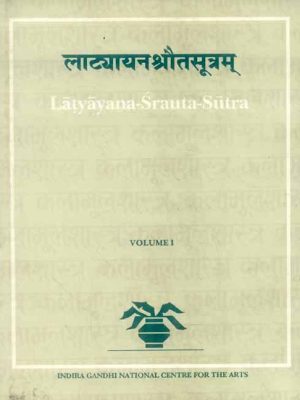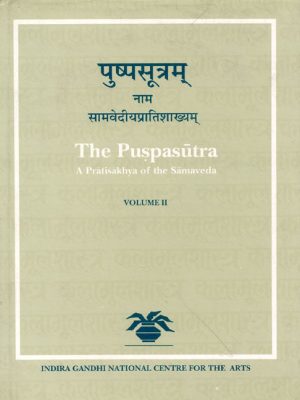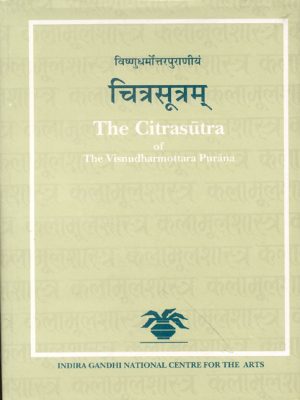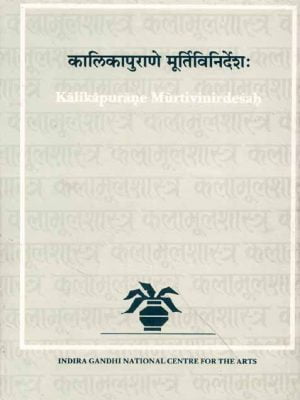Kalamulasastra Series
-
Latyayana Srauta Sutra (3 Vols.)
Latyayana Srauta Sutra (3 Vols.)
The Srauta Sutras are an essential part of the larger body of literature known as the Sutras. They are known for distilling the substance of the Vedic scriptures known as the Samhitas and the Brahmanas into a condensed form, which helps to reinforce India’s long-standing custom of offering sacrifices. The Yajurveda and the Samaveda, as well as the Rgveda, which is known to have developed a variety of recensions with differences in utterance and practise, are also important to the sacrificial tradition in India, which is widely known to be based primarily on the Rgveda, which is the oldest book that was written by humans.
₹2,200.00Latyayana Srauta Sutra (3 Vols.)
₹2,200.00 -
The Puspasutra (2 Vols.): A Pratisakhya of the Samaveda
The Puspasutra (2 Vols.): A Pratisakhya of the Samaveda
One of the most important supplementary works in the body of Saman technical literature that is associated with the Kauthuma and Ranayaniya schools is known as the Puspasutra. It discusses the melodies of the Saman people as well as the structure of their music. In the context of this discussion, the word “Puspa” refers to the syllabic expansion that takes place throughout the process of creating a melody out of a verse. The Puspasutra was penned a significant amount of time after the Saman melodies had already been formed.
There are 10 Prapathaka included in the Puspasutra. The first two of them include the names of Samans that appear in the Uttaragana (also known as the Uhagana and the Uhyagana) in the sequence in which they appear in the Uttaragana. The demarcation may be understood based on the declaration of themes that is included in the eighth Prapathaka of the Puspasutra. The Puspasutra is divided into two sections: the northern and the southern recessions. The statement of contents found in the eighth Prapathaka is in complete agreement with the subjects discussed in Prapathakas III to VIII of the southern recession. It is generally agreed that this section of the Puspasutra is the authentic, original component of the text
The Northern recension of Puspasutra attributes this [ext] to Govila not once, but twice. It was formerly attributed to Vararuci, according to the Southern recension. In several places, the Puspasutra describes the chants in detail, including their metres. This gives the appearance that the ganas were repeated in a different metre than what they really were.
It is not easy to pinpoint the precise year when the Puspasutra was written. The initial nucleus was expanded upon by include other components, such as the Vikalpas (alternatives), the remaining bhavas, a more in-depth study of prastava, and the first two Prapathakas. The fact that it now exists with 10 Prapathakas is a significant boon to the academic community that is dedicated to the study of Samavedic chanting. It’s possible that the readers may find the explanations of the technical jargon offered in this version to be really helpful.About the Author(s)
G.H. TARLEKAR
₹1,695.00 -
Citrasutra of the Visnudharmottara Purana
Citrasutra of the Visnudharmottara Purana
“It Has Been Beautiful Produced……. Citrasutra of the Visnudharmottara Purana the Book Presents Intersting Readings as It Includes all the Information Given By The Previous Scholars And Other Texts Regarding the Use And Interpretation Of Technical Terms,Techniques Of Painting And Its Classification.The Author Has Been Successful In The Task She Sets Before Herself To Present A Thoughtful Interpretation Of A Text And The Underlying Aesthetic Theory Of Indian Art And Its Relevance Today.
The author contends that these pieces only make sense when placed inside a framework, which must by definition be contingent, which runs counter to the conventional wisdom that the past may be accessed by us in an unmediated manner via the sacred parts of the texts.
The Citrasutra, which is made up of nine adhyayas or chapters and can be found in the third khanda of the Visnudharmottara Purana, is presented as a work that has been “discovered” and interpreted in a variety of ways in the introduction. As a consequence of this, it has a lengthy history of interpretation that has been contributed to by some of the most influential art historians of the 20th century, such as A. K. Coomaraswamy, Stella Kramrisch, and C. Sivaramamurti. The concerns of art historians, which are bound up with themes of Indian identity and the building of an authentic past, are the source of the interest in the book. This has sparked interest in the work.
Author
PARUL DAVE MUKHERJI
₹1,495.00 -
Kalikapurane Murtivinirdesah
Kalikapurane Murtivinirdesah
The Kalikapurane Murtivinirdesah is the ninth volume in the series of the kalamulasastra project. It is a collection of around 550 lines from the Kalika Purana. These verses include a bodily description of a variety of gods, goddesses, and demi-gods, as well as other beings. Some of them are just abstract ideas, while others are embodied as sculptures made of stone and metal.
The Kalika Purana is a significant upa-purana that has been cited as an authoritative source by the smrti digest authors (nibandhakaras) from almost every region of India. The Kalika Purana is a text that was created in ancient Assam (Kamarupa) in the late ninth or early tenth century A.D. Its purpose was to exalt the mother goddess Kamakhya and to offer a ceremonial system for worshipping her. The Kalika Purana focuses mostly on describing the many incarnations of the goddess, along with providing specifics of their iconography, as well as their horses and weapons. Additionally, it discusses the representations of other gods and goddesses that were housed in Kamarupa. In order to provide a comprehensive picture, all of the verses that deal with the gods and are spread out among the many chapters of the Kalika Purana have been collated according to the gods. The Sanskrit verses are presented with an accurate translation of those verses into English.
Author
Dr. Biswanarayan Shastri
₹395.00Kalikapurane Murtivinirdesah
₹395.00



